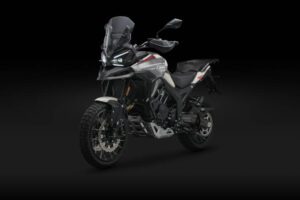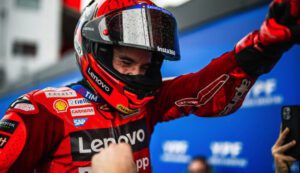Scooter stories: Mally Lamb, the ‘60s mod

Mally Lamb was first seduced by the fashion – the sharp, tailored suits, shirt and tie, desert boots, and US army parkas.
Then there was the music of the Small Faces and The Kinks and, of course, the Italian Lambrettas and Vespas that defined the very British mod subculture that began in the late 1950s but took hold in the ‘60s.
He bought his first Lambretta, an Li150, in 1965 at the not strictly legal age of 15, and threw himself into a movement that prioritised style and sartorial elegance over the grease and horsepower of their motorcycle-riding nemesis, the rockers.
“I’d always liked clothes – that was the main thing to start with,” he says, chatting in his self-built home on the edge of Norwich. “It all started in London, and grew around the fashions in Carnaby Street, and it filtered out to the rest of the country. I remember a group of us going to Burtons to get measured up for our first suits on a Saturday morning.
“It cost us £5 for a three-piece suit. It was a lot of money for young lads then, and we had to pay for it weekly, but it was lovely.
‘We looked sharp’
“The rockers just had a greasy leather jacket, and the mods could pull the girls better because we looked sharp with nice suits, and even bowler hats.
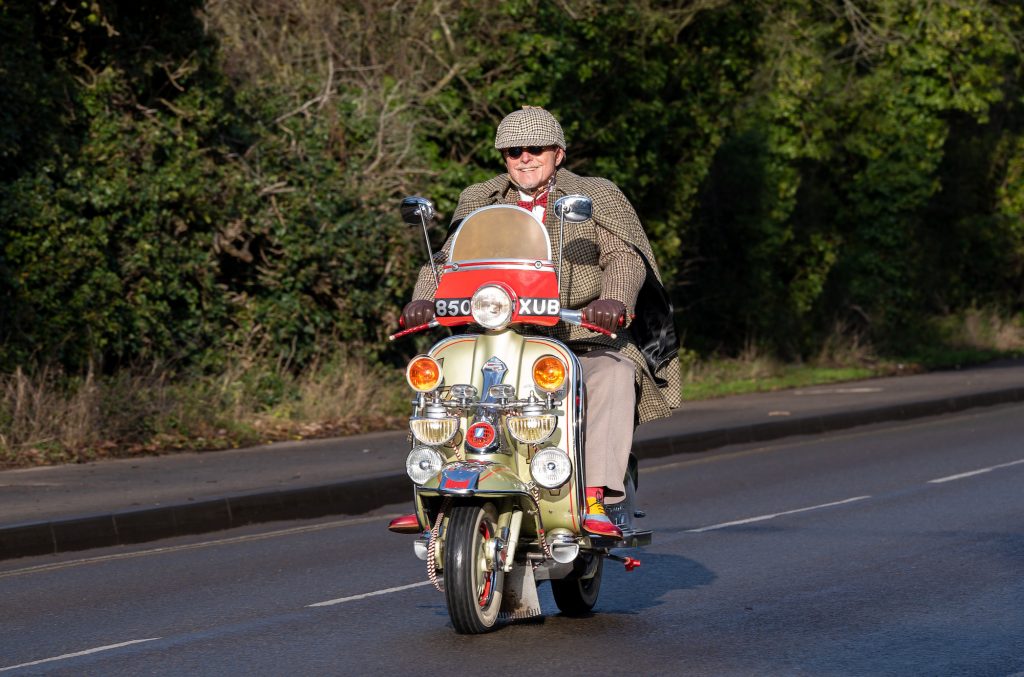 Mally riding his TV175
Mally riding his TV175
“You didn’t have to go to a nightclub, you’d just wait outside on the scooter, and if any girls came out they’d just hop on the back and away you go, no crash hat, which was dangerous, really.
“One of my mates, Tony Dye, looked exactly like Steve Marriott (Small Faces lead singer) – it was unbelievable – and of course all the girls were after him.”
To keep the rain off, keep them warm, and protect their expensive clothes from their oily scooters, the mods wore loose-fitting US military parkas sourced cheaply from army surplus stores.
“I had an M-1951, but a mate of mine had an earlier M-1948, which would be worth a lot of money now,” says Mally. “The 48 had different toggles and on the left sleeve there was a little pocket for the American military to put their cigarettes.”
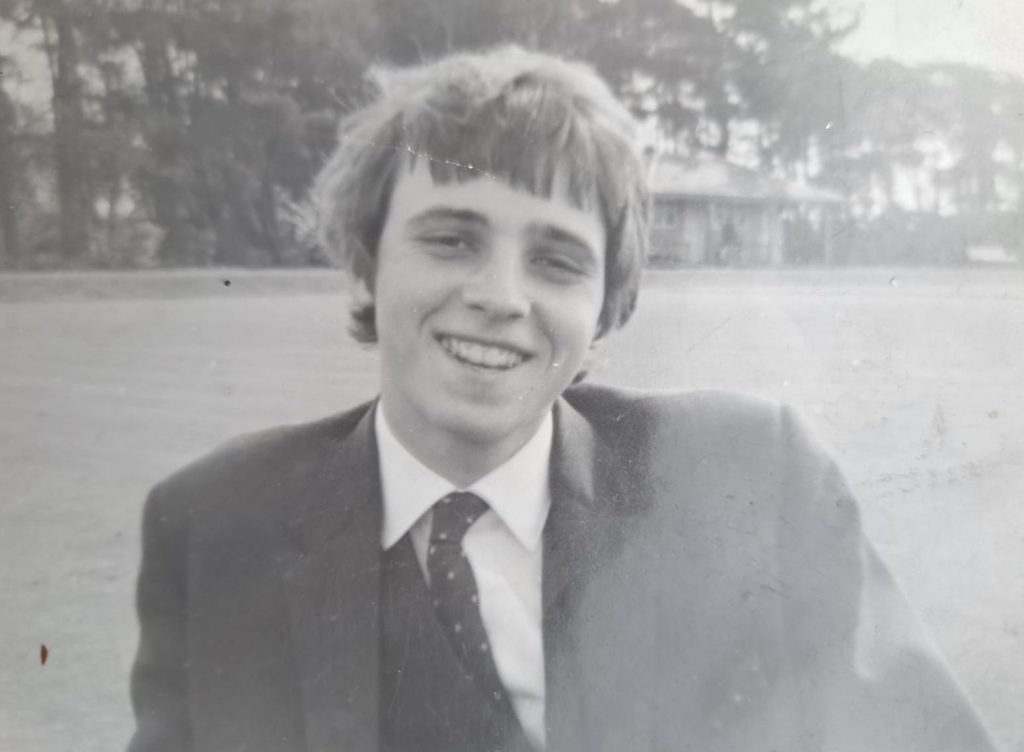 Mally as a teenager at Eaton Park in Norwich
Mally as a teenager at Eaton Park in Norwich
The pockets were more likely to be used by the mods for storing ‘blues’ and ‘black bombers’, part-amphetamines often prescribed as diet pills and referred to as uppers that allowed them to keep partying over a long Bank Holiday weekend.
“No-one ever smoked any dope, it was always pills,” says Mally. “People used to put a pill in a Coca Cola, it would sizzle up and you’d down it. They were quite hard to get hold of round here though.”
Whether or not they played a part in the clashes between mods and rockers in Brighton over the notorious Whitsun weekend of June 1964, a law was quickly passed banning possession without a prescription.
Skirmishes with rockers
Away from London and the south coast, Mally and his mates had their own skirmishes with rockers, the two tribes gathering outside their own cafes, bars and ballrooms in Norwich.
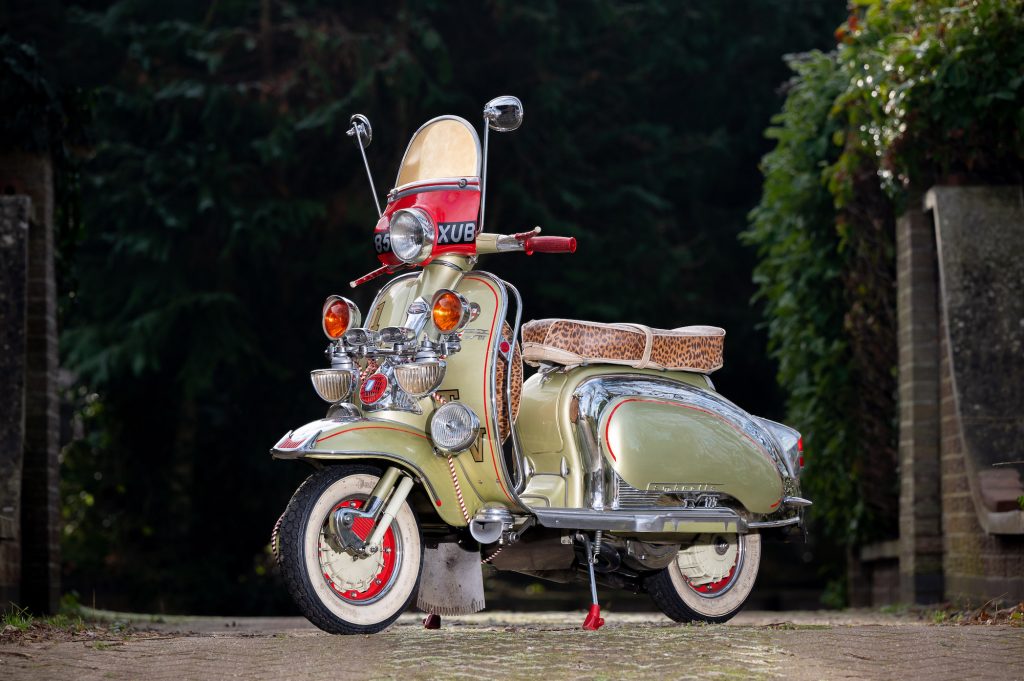
“We had Bedfords bar, but we weren’t old enough to go in, and there were the Purdy’s cafe boys, who were a lot older than us, and a group who would hang out at the Gala ballroom,” he remembers. “The rockers were at the Three Cs, they were the grebos, as I called them; Number Ten opposite the train station; and the Buttery – they were the ton-up boys.
“In ‘67 I thought ‘right, we’ll all go down to the Three Cs’. We got in there first, us mods, several of us. I’ve never seen so many motorbikes turn up – they kicked us out in the end but they didn’t give us a hiding. We never went down there again though!”
By then, Mally had bought a Lambretta Li150 Silver Special, on which he passed his bike test and owned through to 1969, the last knockings of the mod culture.
He would occasionally fall foul of lurking rockers while riding around the city, though he admits he wasn’t entirely blameless.
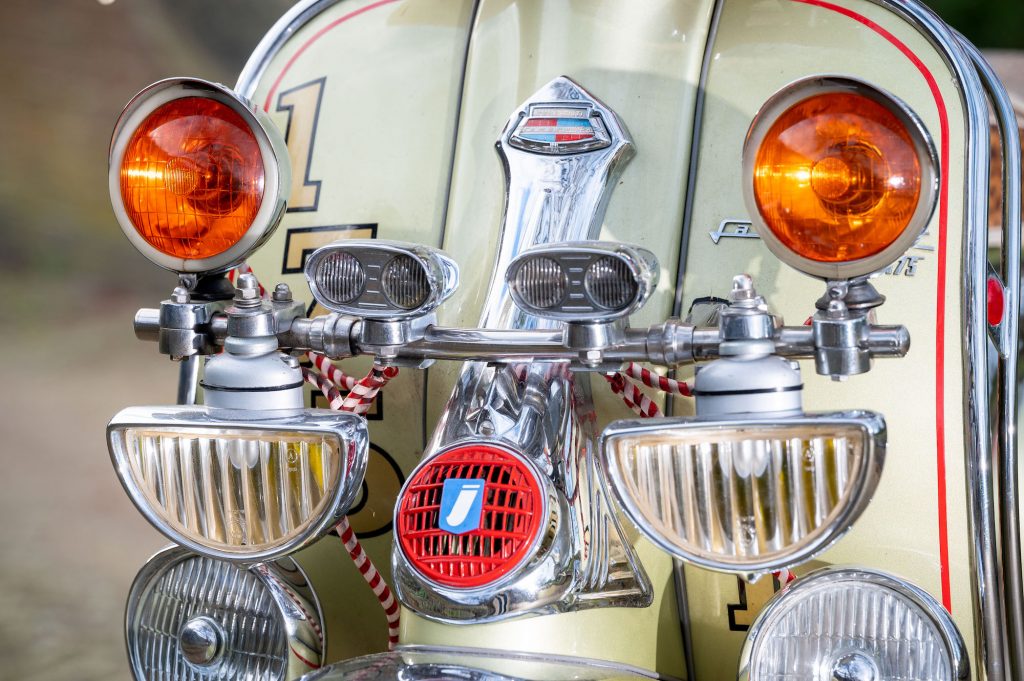
“I remember picking a girl up one night and, going home, the rockers were outside a cafe. I gave them the bird as I rode past, didn’t I?” he smiles. “I got to the top of the hill, and that was it, they were on me. I said ‘give me a hiding if you want, but leave the girl alone’. They kicked the scooter over, gave me a good kicking and I ended up in hospital.
“It was a Friday night, and I was meant to work Saturday, but I couldn’t because I had two cracked ribs.
“Another time, our scooters were parked up and a bunch of rockers in this big old Vauxhall came round the corner. They had a scaffold pole out of the window trying to knock the scooters over.”
Even though the Vespas and Lambrettas were significantly slower than the rockers’ BSAs, Triumphs and Nortons, sometimes they got away.
“They used to hang about outside the fish shop on the ring road, and wait for us as we went past,” he says. “One time, we gave them the bird but they never caught us because we used the short cuts and gave them the slip.”
Scooters at the seaside
Just like in the city, the two groups had their own areas either end of Great Yarmouth seafront when all roads lead to the east coast on summer weekends.
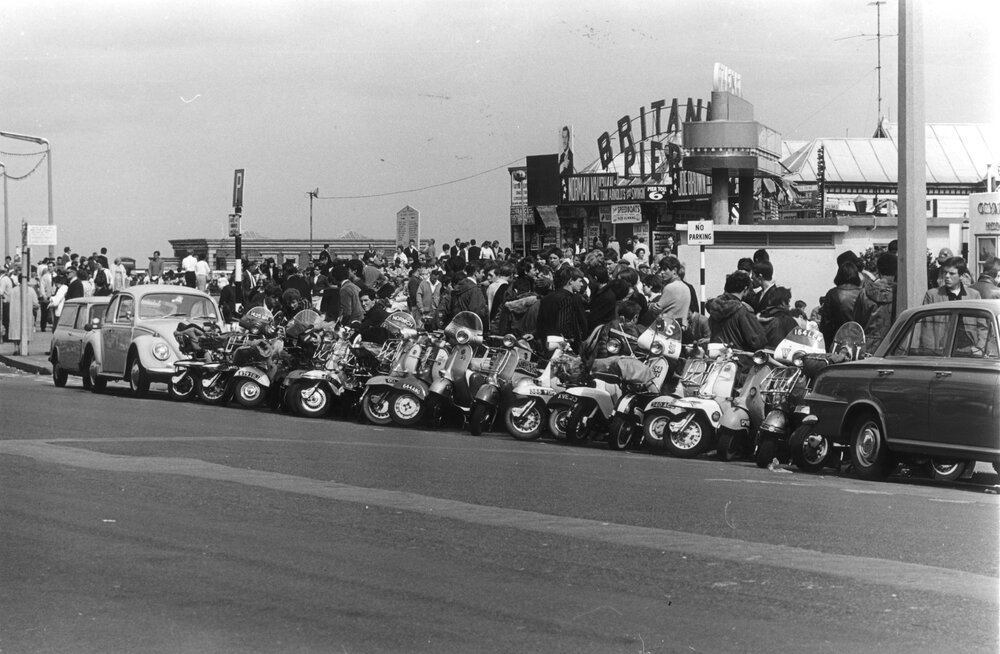 Mods at Great Yarmouth in 1965
Mods at Great Yarmouth in 1965
“They were down the fairground end and we were up near the Tower ballroom,” he says. “Once, we went down to them, there were more of us, and these two rockers got on the big wheel, and they wouldn’t get off because we were there waiting for them. Eventually, the old bill got us and moved us on.
“You’d just have running battles, all a load of rubbish really, looking back. We were just different tribes, that was all. I remember a load of us going to Yarmouth one afternoon on a Sunday, and this biker had some sort of stick and was trying to push us off as we rode along, and we were trying to kick him off.”
There were also trips to Clacton, Cromer, and Hemsby – not organised rallies, just impromptu runs to the coast.
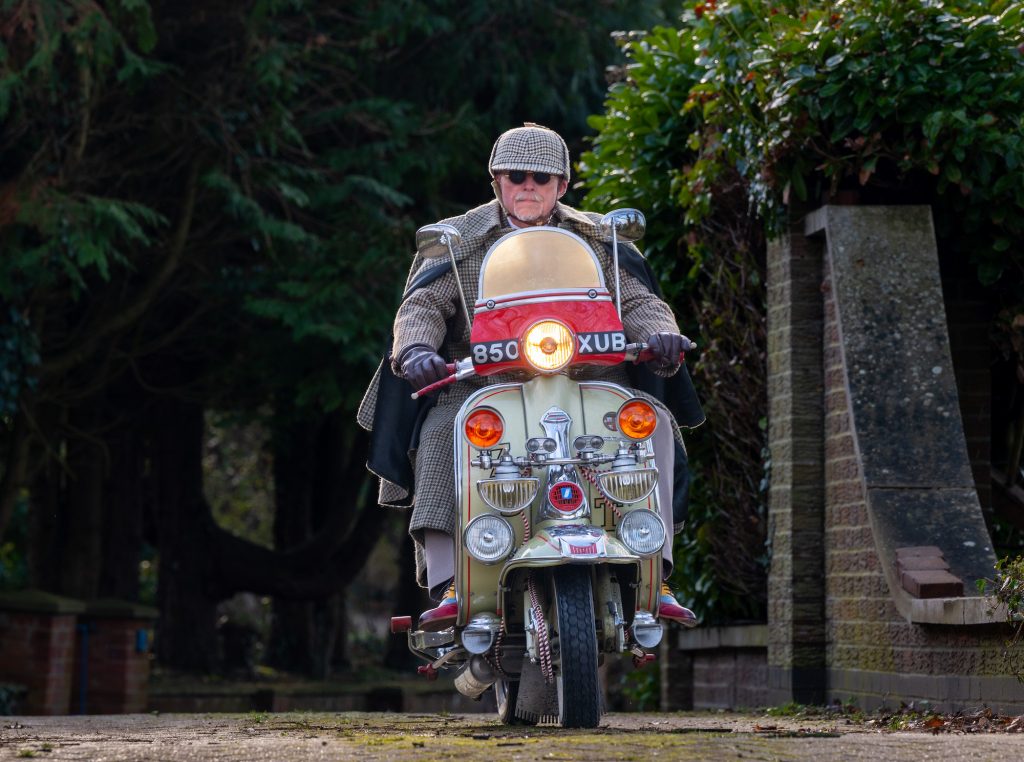
“We’d meet at City Hall at 10am and set off somewhere,” he says. “When we went to Clacton, around the time of the World Cup in June 1966, we met some boys at the roundabout near Colchester and rode on.
“We didn’t know each other, but we just got together, which is nice. It gave us a sense of belonging, just like with Jimmy in Quadrophenia. You felt you were part of something.”
In the space of 12 months from June 1966 to 1967, the Small Faces and The Kinks both played at Earlham Park in Norwich, and Mally and his mates were there, parking their scooters outside and revelling in seeing their heroes up close.
But just like not all motorcyclists were rockers, not all who rode scooters were mods – there were scooter clubs dedicated to running so-called gymkhanas, including time trials, navigation rallies, treasure hunts, and even scooter jousting.
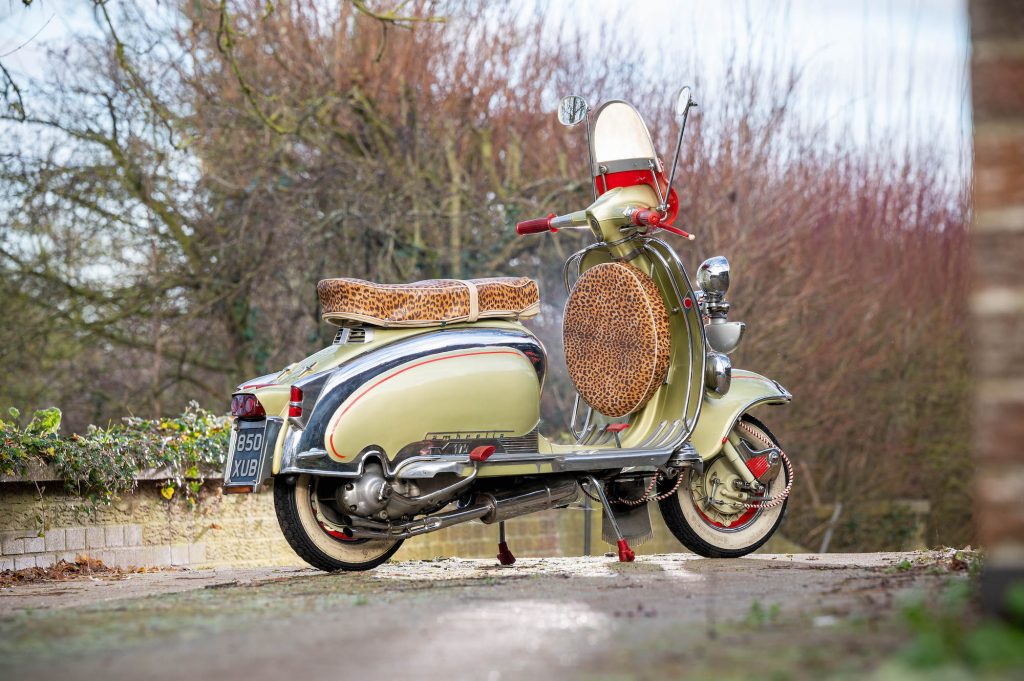
“The only jousting we did was with the rockers,” laughs Mally. “From about 1969, skinheads were riding scooters too, like my older brother, and then scooter boys and girls.”
By 1969, the mod culture as it had evolved throughout the decade was all but over, and Mally swapped his scooter for a Mini, got married and had children.
“I did have an SX200 for a while after I got the Mini, but we were all getting older and it died out with everyone getting girlfriends and getting married,” he says. “I still had the smart clothes and the parka, but it was all over really.”
A builder by trade, Mally spent much of the mod revival period of the late ‘70s and early ‘80s working in Germany and Belgium, as tradesmen fled recession-hit Britain to earn good money abroad.
Mod revival
Fuelled by Quadrophenia and Paul Weller’s The Jam, the mod revival was a further evolution of the original mod scene, the music a fusion of ‘60s R&B and mod bands with the energy and verve of punk.
Parkas were still seen on the scooter rallies of the ‘80s, but there was an equal number of US air force-style green bomber jackets, with faded jeans or Sta-Prest trousers and Fred Perry polo shirts taking over from Italian-style suits and shirt and tie, with a liberal sprinkling of Doc Martens replacing desert boots.
“They didn’t dress the same way – they didn’t wear suits, they were more casual, and a lot of them were scooter boys rather than mods,” he says. “I never wore a pair of jeans, at least not after I was 10 or 11 maybe, never wore trainers, and never wore a t-shirt.
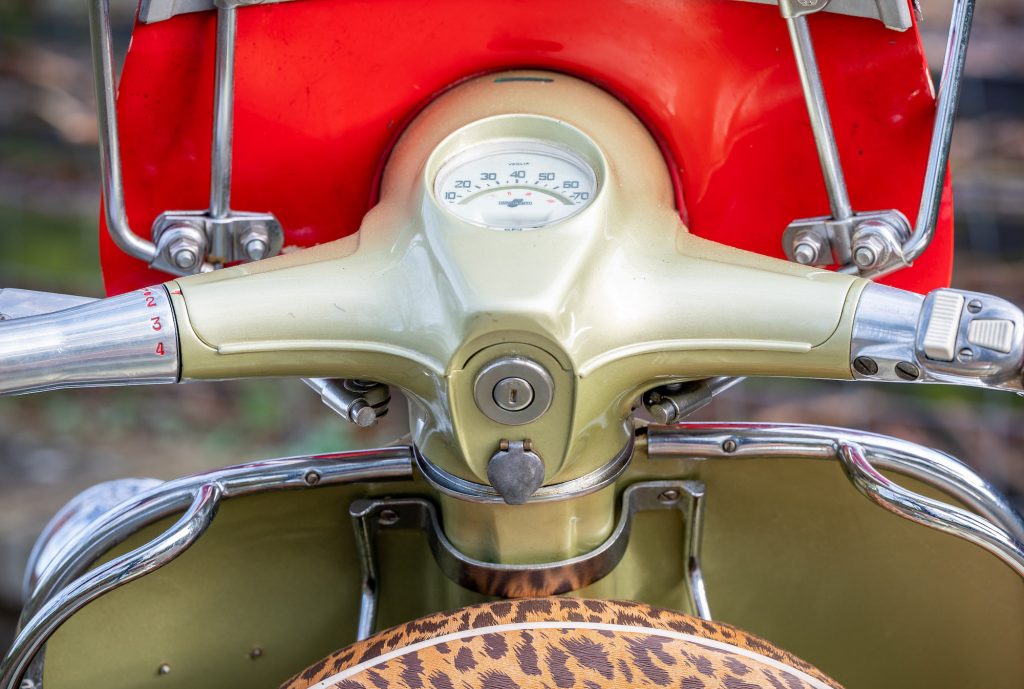
“My youngest boy says to me ‘dad, when you die I’m going to put you in a pair of jeans.’ I said ‘no you won’t!’”
Although Mally loved the music of Blur and Oasis in the mid ‘90s, the next mini mod revival – with Weller again a figurehead – didn’t move him to buy another scooter.
It wasn’t until the internet was gathering steam that he started looking for another Lambretta, aided and abetted by his daughter Sarah, who told him “why don’t you get one? You should get one”.
He bought a GP, on which he never felt quite right.
“I didn’t really suit it because mods never had GPs because it didn’t come until ‘68 or ‘69, so you would never have got a GP modded up back in the day,” he says. “I never felt comfortable with it, being a mod. Scooterists ride GPs.”
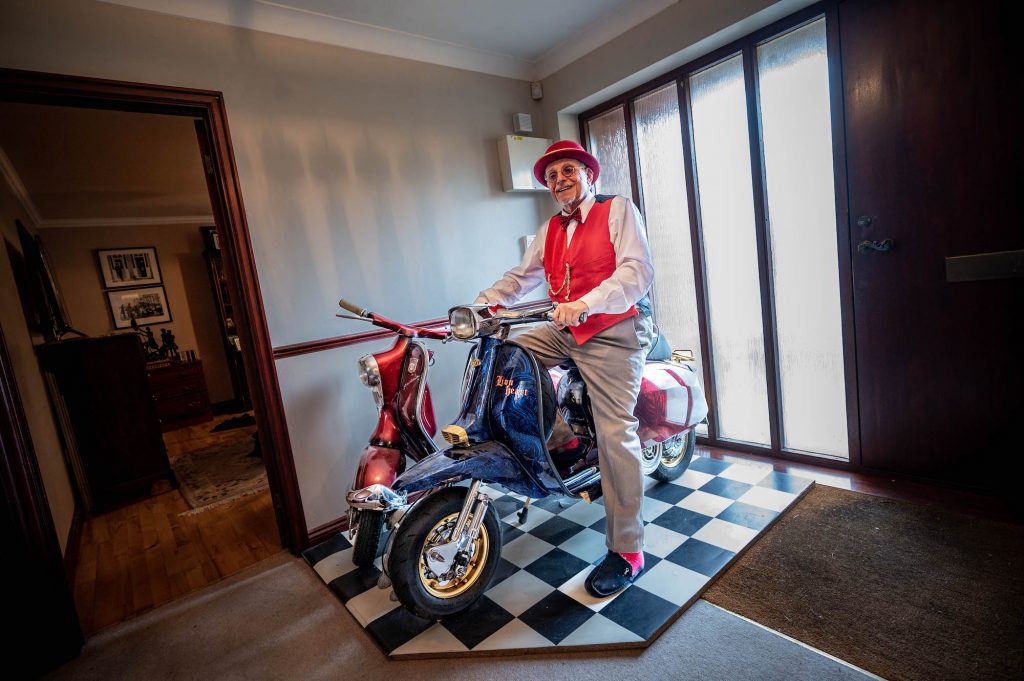 Scooters in the hallway
Scooters in the hallway
An electric start NSU Prima 150 (“well built, but too slow”), was joined by a 1979 GP200 TS1, both of which sit just inside Mally’s front door on a specially-made tiled area – with stills from Quadrophenia, including one signed by Phil Daniels (Jimmy) and Leslie Ash (Steph), lining the stairs wall.
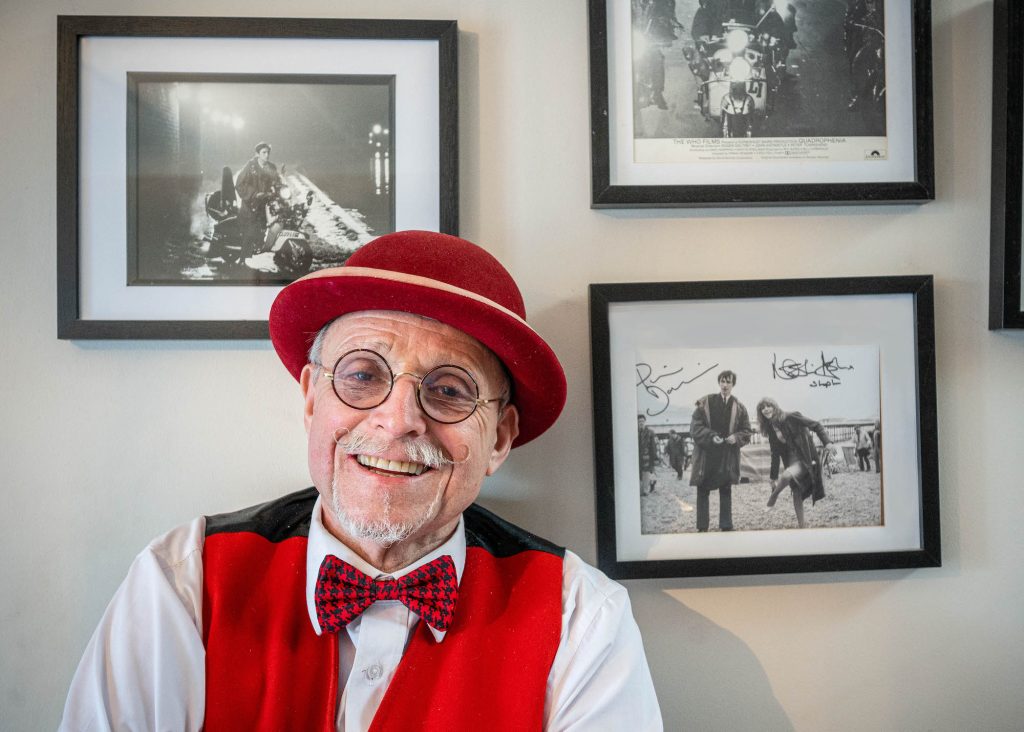 Mally with scenes from Quadrophenia
Mally with scenes from Quadrophenia
Rare Lambretta ridgeback
The scooter he rides regularly today, and featured in our photographs, is an early and rare 1959 Lambretta TV175 ridgeback bought about 10 years ago and previously owned by renowned scooter guru Disco Dez.
“It’s one of the rarest scooters, because when they upgraded the TV from the 150 to the 175 they found out the frame wasn’t strong enough, so they had to send it back to Innocenti in Italy to be strengthened,” he says, the factory adding a welded ridge down both sides of the frame tube, which was later dropped when they found a more permanent solution.
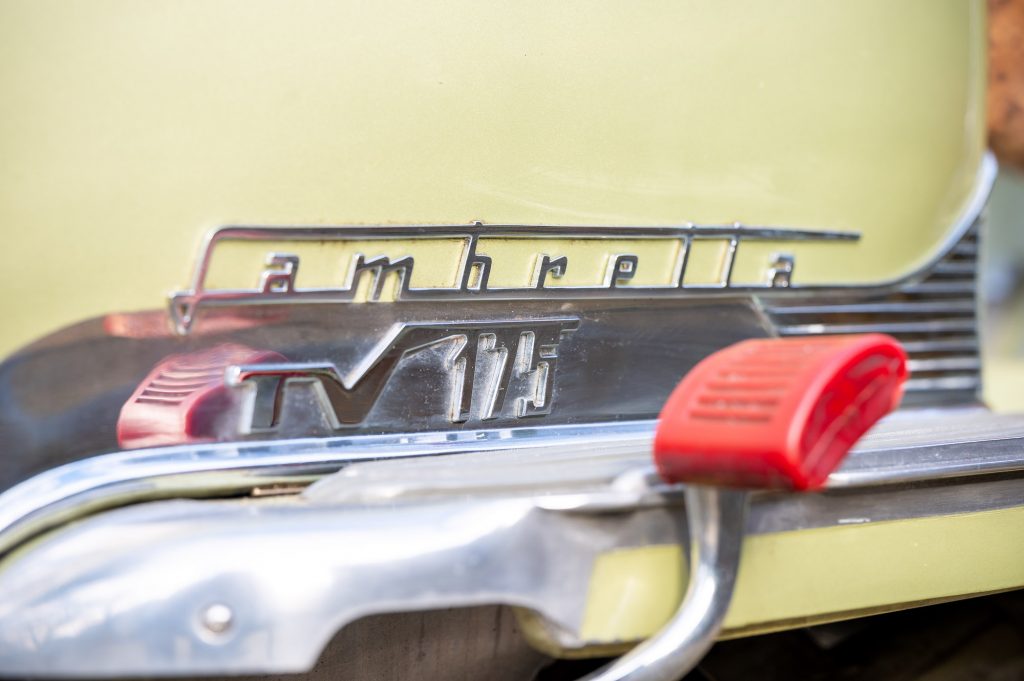
“It was in good nick apart from the bottom of the side panels, which had rusted, so I had that done and I’ve added plenty to it since – you wouldn’t believe what it’s cost me.”
Mally’s additions include original Jag and Miller lights, the Lambretta “done out like it would have been in the ‘60s”.
Now 72, he remains an active part of the scooter scene, joining up with younger (though mostly not that young) devotees on runs to the coast just like he did all those years ago, and attending scooter and bike meets at Whitwell Station in north Norfolk and Two Wheel Tuesdays at the Ox & Plough in Old Buckenham.
“It’s all arranged over Facebook these days,” he says, “and a group of us just go for rides out. The trouble is, they all want to ride faster than me.
“We went to Hemsby, and I couldn’t keep up with them. When they were ready to leave, I had to leave a quarter of an hour before them, but they still caught me up.
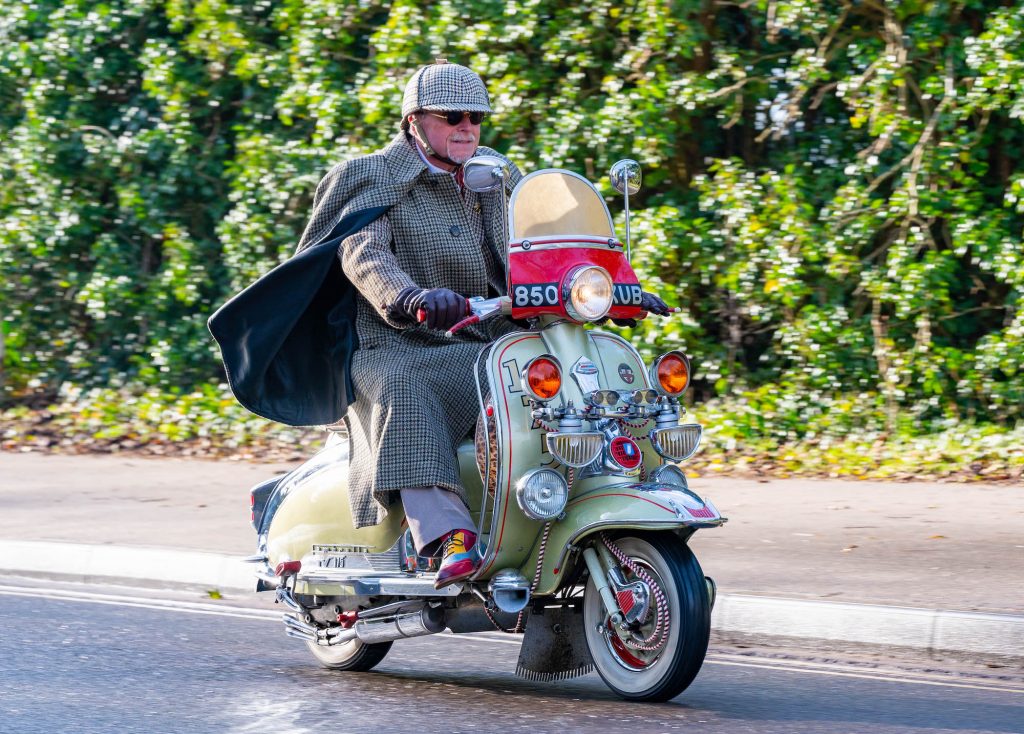
“I only do about 40-45mph, but they want me to go in front in case I break down and they can help me. I said ‘if I break down it doesn’t matter, I’m in the AA’, but no, they persist in following me, and then they moan at me.
“I say ‘will you be doing that when you’re 72?’. Some of them won’t be alive how they ride!”
Still a mod – but different
Mally may no longer wear the uniform of a 60s mod – gone are the slim-fit suits and parka – but he remains impeccably turned out, today sporting the garb of an eccentric English gentleman.
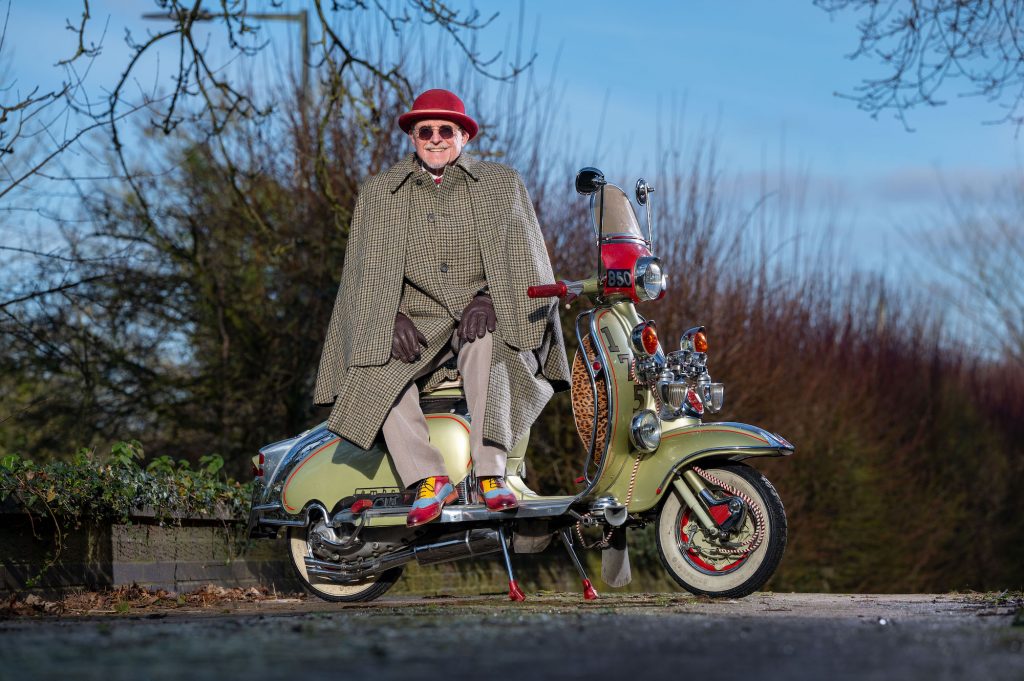
There’s the second world war-style ‘pinks’ trousers, bright red waistcoat, bow tie, and bowler hat, multi-coloured Oxford brogues, and an Inverness woollen cape.
To cap it off, there’s a matching deer-stalker style Everoak cork helmet, which is legal despite attracting the attention of police on occasion.
“This is what a mod looks like in 2023,” he smiles. “I get a fair amount of comments, but I’m just different, and I think that’s how mods were when they first appeared – different.”
At the centre of it all were the scooters, cheap to buy (at the time), easy to customise with mirrors, lights and paintwork, and as stylish as the mods’ clothing and haircuts.
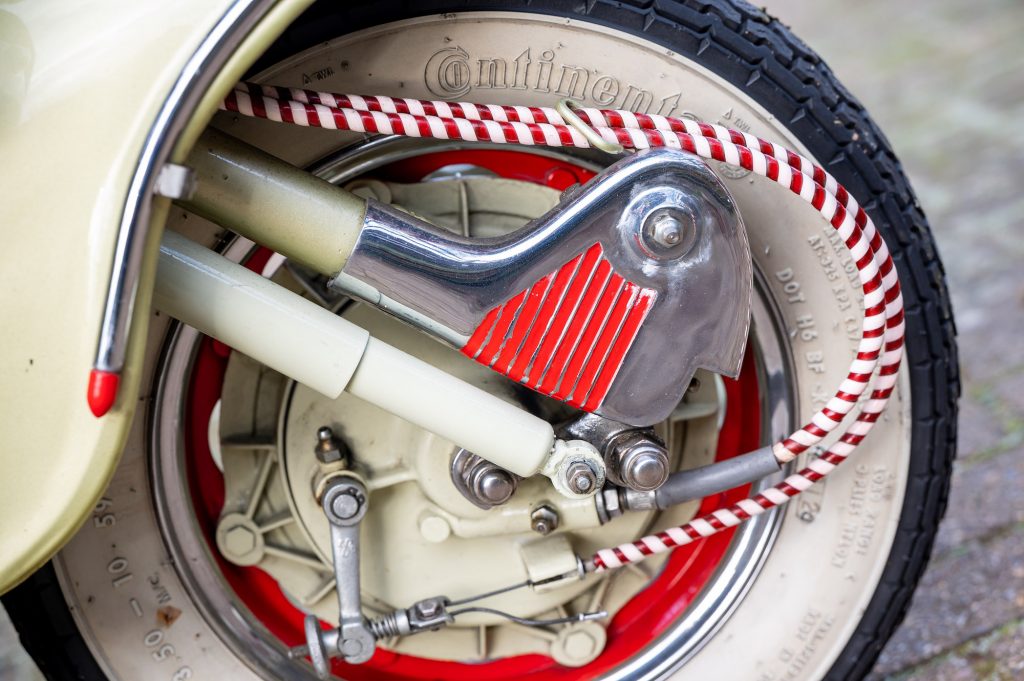
To Mally and tens of thousands like him, they represented freedom, rebellion, and a new way of life.
Photographs by Simon Finlay.
Scooter stories is a series of articles exploring the lives and experiences of different types of scooter riders and collectors. More stories will be added in the coming months. Click on the category link below to read more.
Scooter Stories

